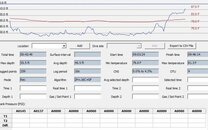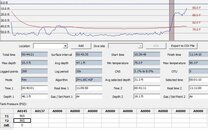We normally get bent from exceeding the maximum supersaturation (M-Values) that a compartment can tolerate however I still can't see anything wrong with those profiles... I'm not a chamber doc of course. I'd look at PFO.
Do you smoke?
Have never smoked, gave up drinking alcohol completely nearly 8 years ago. I am moderately overweight (which I constantly work on) I've been in better shape, but have been in much worse shape during my 20 years of diving. While in the chamber, BP was around 130/90, resting heart rate upper 50's.
There are a couple things as food for thought....This dive was on Saturday. I felt rested and hydrated. However, on the Thursday before this dive, I spent early morning into the evening doing landscaping work. I wanted to get it all done in one day to have minimal impact on diving. It was well into the 90's, and about as close to 100% humidity as you can get without actually raining. There was a midst in the air all day. I took frequent breaks, but I really felt like I should have been able to do more than I was able to do without taking so many breaks. I know the signs of heat stroke, and it never got that far. It was a rough day, so I didn't dive on Friday. Just took it easy.
I'm on Adderall 20 mg., twice daily. I have not been able to find anything online regarding Adderall and diving, so I stayed on it. Chamber doc said it could have had an impact, but I've been on it for 6 months with no real side effects.
Seas were calm, and it was a beautiful day. We got to see armored personnel carriers get pushed off a barge as they were being added to the dive site. This was an unadvertised bonus, and then were the first divers to dive on them. How cool is that?! No current or surge, no exertion whatever. I did some semi-serious spearfishing, and took GoPro video.
You say you don't see anything wrong with the profile, but you are not a chamber doc. I can tell you that the first chamber doc agreed with you, but later the director of the department pulled out his tables and well you know the outcome when you round up to 60 ft. and assume a square profile, and include the ascent times.
---------- Post added September 5th, 2013 at 04:45 PM ----------
That you experienced both weakness/paralysis and numbness appears to me as a nerve bubble or bubbles, not circulatory-system bubbles per a PFO. If you want to get the test to rule out a PFO, that is never a bad idea; however, I personally don't think that is the issue here. No, I'm not a doctor -- I'm a hyperbaric tender who treats divers. I've seen a number of DCS patients with confirmed PFOs and yours doesn't fit with those.
So you are not a doctor, but your life's work is treating divers in a hyperbaric chamber. I'll take that! This is one of my reasons for sharing this information....input from folks like you. The thing that made me think circulatory was the stroke-like symptoms. So much like a TIA that I suspected a bubble in the brain, or given my profile, an actual TIA from some other cause! FYI, I did get a CAT scan in the ER before they shipped me off to rule out stroke. But if the symptoms and therefore bubble were gone, what would they see anyway? Anyway, negative for stroke. And since I have some mild residual pain in my arm, that is really telling me that it was a bubble in my arm. And I have follow up appointments scheduled.
You are very lucky -- that the boat had sufficient oxygen and that the symptoms resolved on surface oxygen without rebound. While many chambers get a bad rap for over-treating divers, your recompression treatment was appropriate and I'm glad that you received it.
I'm a lucky guy all around. You should meet my wife and son! That 10 minutes when I wasn't sure if I was going to live or die, they were all I could think about. I'm glad to have received the treatment as well. The staff at the chamber were top notch. Can't find the words to express how good they were to me and my family. The doc called me on Labor Day to check on me. That has never happened to me before. Oh yea, the boat and dive operator, got to give a shout out to them. Coastal Scuba in North Myrtle Beach. The O2 was in perfect working order, and plenty to get me to shore. Their actions were flawless.
You've received some good advice here about how to protect yourself in the future: Extending SI's and stops, using nitrox, making sure you're fit to dive -- appropriately hydrated and so forth. You may never know exactly why this event occurred -- usually it is not just one thing but a domino effect of several things. Another item to consider is what you do after a dive -- especially on a warm, sunny day. (I think someone brought this up but it is worth repeating.) It could have been the body-warmth from gear straightening that did you in...
Absolutely. Nitrox on air tables for me from now on. You're being kind to refrain from commenting on my complacency, but I'm aware that complacency has killed many divers way more experienced and skilled than I. As far as wake up calls go, this was just about perfect. Something is looking out for me.






